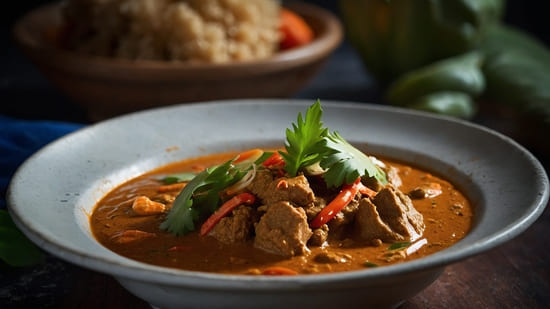
Rebecca Thompson
Dedicated woman chef with a passion for creating unforgettable main dishes. Innovative and skilled in crafting diverse flavors that leave a lasting impression.

Dedicated woman chef with a passion for creating unforgettable main dishes. Innovative and skilled in crafting diverse flavors that leave a lasting impression.
Panang Curry Paste, a staple in Thai cuisine, is a rich and robust spice mix often used in curries, soups, and sauces. This ingredient offers an unparalleled blend of heat, sweetness, and savory flavors. It is vegan, gluten-free, and naturally sweetened, and quite popular in home cooking because of its similarity to takeout cuisine.
Despite its Thai origin, Panang Curry Paste is now globally recognized and is widely used because of its unique taste, which adds a flavor punch to any dish. It contains staple Thai ingredients like ginger, lemongrass, and Thai chili peppers, combined with universal favorites like peanut butter, salt, garlic, and onion. This culinary wonder also shines in festive occasions such as birthdays and anniversaries, giving meals an exotic twist.

First, deseed the Thai chili peppers by trimming the stem ends and carefully cutting a lengthwise slit in each pepper, opening it, and using your fingers to scrape out the seeds. Place your deseeded peppers in a heatproof bowl and cover with boiling water. Set aside.
Add whole coriander and cumin seeds to a small skillet and toast over medium-low heat for 4-5 minutes or until fragrant and slightly deeper in color, shaking / stirring occasionally. Be careful not to burn!
Once seeds are toasted, add to a mortar and pestle and crush a bit. If you don’t have a mortar and pestle, slightly cool the seeds, add them to a sandwich bag, and crush with a rolling pin or a heavy pan. Set aside.
Drain the soaked chilis and add them to a small blender (or small food processor) along with the toasted spices and remaining ingredients (onion, peanut butter, maple syrup, oil / water, miso paste, lemongrass, ginger, lime zest, garlic, and salt).
Blend / mix until a paste forms, scraping down the sides as needed. The lemongrass can be difficult to grind at first, but give it time! Add more water or oil as needed to encourage blending.
Taste and adjust flavor as needed, adding more lime zest for brightness, salt for overall flavor, chilies for heat, maple syrup for sweetness, oil (or water) for creaminess / to thin, garlic for zing, or peanut butter for richness.
Store curry paste in a jar in the refrigerator for up to 10 days. For longer storage, transfer paste to an ice cube tray, freeze, then store in a freezer-safe container for up to 1 month.
Thai chilis can be hot! When deseeding them, you might want to wear gloves if you have a sensitive skin, and/or wash your hands thoroughly after deseeding. If your hands burn after deseeding the peppers, use a neutral oil (like olive or avocado oil) to attract and remove the capsaicin. Wash thoroughly with soap afterwards.
If you prefer milder curries, consider swapping dried Thai chillies with dried guajillo chilies. These are less spicy but still offer a rich flavor suited to culinary use. They can be substituted on a 1:1 basis.
This Curry paste is ideal for a variety of dishes, including soups, sauces, and salad dressings. It also makes a fantastic addition to a stir fry, providing a complex, robust flavor profile that can enhance various proteins, from tofu to chicken.
Yes, almond butter can be a delicious alternative to peanut butter, providing a slightly different but equally rich-tasting profile. If you prefer a nut-free option, consider using sunflower seed butter or tahini.
Fresh ginger is highly recommended, as it contributes to the vibrant, fresh flavor of the Panang Curry paste. However, in a pinch, ground ginger can be used. The rule of thumb is 1/8 of a teaspoon of ground ginger for every tablespoon of fresh ginger. Add more if you feel it's not enough.
Avocado or olive oil is preferred as it lends to the overall flavor and creaminess. Additionally, both have high smoking points which makes them suitable for all types of cooking. If not available, you can use other vegetable oils but it might alter the taste slightly.
This curry paste is versatile and works great in a variety of dishes. You can try it in Panang Curry Stir-fry, Panang Curry Noodles, or mix it with coconut milk for a delicious curry sauce for meats or veggies.
Yes, you can. However, if you have some time, letting it rest in the fridge for a few hours or overnight can intensify the flavors as they have more time to meld together.